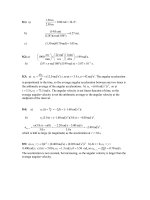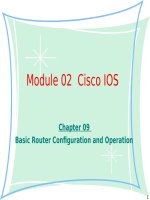Chapter+09+Intruders 1
Bạn đang xem bản rút gọn của tài liệu. Xem và tải ngay bản đầy đủ của tài liệu tại đây (1.78 MB, 38 trang )
Cryptography and Network Security
Chapter 9
Intruders
Lectured by
Nguyễn Đức Thái
Outline
Intruders
Intrusion Detection
Password Management
2
Key Points
Unauthorized intrusion into a computer system or
network is one of the most serious threats to computer
security.
Intrusion detection systems have been developed to
provide early warning of an intrusion so that defensive
action can be taken to prevent or minimize damage.
Intrusion detection involves detecting unusual patterns
of activity or patterns of activity that are known to
correlate with intrusions.
One important element of intrusion prevention is
password management, with the goal of preventing
unauthorized users from having access to the passwords
of others.
3
Intruders
A significant security problem for networked
systems is hostile, or at least unwanted, trespass by
users or software.
User trespass can take the form of unauthorized
logon to a machine or, in the case of an authorized
user, acquisition of privileges or performance of
actions beyond those that have been authorized.
Software trespass can take the form of a virus,
worm, or Trojan horse
4
Intruders
One of the two most publicized threats to security
is the intruder (the other is viruses), often referred
to as a hacker or cracker.
3 classes of intruders:
• Masquerader: An individual who is not authorized to use the
computer and who penetrates a system’s access controls to exploit a
legitimate user’s account
• Misfeasor: A legitimate user who accesses data, programs, or
resources for which such access is not authorized, or who is
authorized for such access but misuses his or her privileges
• Clandestine user: An individual who seizes supervisory control
of the system and uses this control to evade auditing and access
controls or to suppress audit collection
5
Intruders
Masquerader outsider
Misfeasor: insider
Clandestine user: either outsider or insider
Intruder attacks range (benign serious)
• Benign: simply wish to explore internets and see what is out there
• Serious: access/modify data, disrupt system.
6
Examples of Intrusions
Performing a remote root compromise of an e-mail server
Defacing a Web server
Guessing and cracking passwords
Copying a database containing credit card numbers
Viewing sensitive data, including payroll records and medical
information, without authorization
Running a packet sniffer on a workstation to capture usernames
and passwords
Using a permission error on an anonymous FTP server to distribute
pirated software and music files
Dialing into an unsecured modem and gaining internal network
access
Posing as an executive, calling the help desk, resetting the
executive’s e-mail password, and learning the new password
Using an unattended, logged-in workstation without permission 7
Intruders Behavior Pattern
The techniques and behavior patterns of intruders are
constantly shifting, to exploit newly discovered weaknesses
and to evade detection and countermeasures.
Even so, intruders typically follow one of a number of
recognizable behavior patterns, and these patterns typically
differ from those of ordinary users.
8
Hackers
Motivated by thrill of access and status
• the hacking community is a strong meritocracy.
• status is determined by level of competence
Benign intruders might be tolerable, although they do
consume resources and may slow performance for legitimate
users.
However, there is no way in advance to know whether an
intruder will be benign or malign.
IDSs and IPSs are designed to counter this type of hacker
threat.
One of the results of the growing awareness of the intruder
problem has been the establishment of a number of
Computer Emergency Response Teams (CERTs).
collect / disseminate vulnerability info / responses
9
Hackers Behavior Examples
1. Select the target using IP lookup tools such as NSLookup,
Dig, and others.
2. Map network for accessible services using tools such as
NMAP.
3. Identify potentially vulnerable services (in this case,
pcAnywhere).
4. Brute force (guess) pcAnywhere password.
5. Install remote administration tool called DameWare.
6. Wait for administrator to log on and capture his password.
7. Use that password to access remainder of network.
10
Criminals
organized groups of hackers now a threat
• corporation / government / loosely affiliated gangs
• typically young
• often Eastern European or Russian hackers
• often target credit cards on e-commerce server
criminal hackers usually have specific targets
once penetrated act quickly and get out
IDS / IPS help but less effective
sensitive data needs strong protection
11
Criminal Enterprise Behavior Examples
1. Act quickly and precisely to make their activities harder to
detect.
2. Exploit perimeter through vulnerable ports.
3. Use Trojan horses (hidden software) to leave back doors
for reentry.
4. Use sniffers to capture passwords.
5. Do not stick around until noticed.
6. Make few or no mistakes.
12
Insider Attacks
among most difficult to detect and prevent
employees have access & systems knowledge
may be motivated by revenge / entitlement
• when employment terminated
• taking customer data when move to competitor
IDS / IPS may help but also need:
• least privilege, monitor logs, strong authentication,
termination process to block access & mirror data
13
Insider Behavior Examples
1. Create network accounts for themselves and their friends.
2. Access accounts and applications they wouldn’t normally
use for their daily jobs.
3. E-mail former and prospective employers.
4. Conduct furtive instant-messaging chats.
5. Visit Web sites that cater to disgruntled employees, such
as f’dcompany.com.
6. Perform large downloads and file copying.
7. Access the network during off hours.
14
Intrusion Techniques
The objective of the intruder is to gain access to a system
or to increase the range of privileges accessible on a
system.
Most initial attacks use system or software
vulnerabilities that allow a user to execute code that
opens a back door into the system.
Alternatively, the intruder attempts to acquire
information that should have been protected.
In some cases, this information is in the form of a user
password.
With knowledge of some other user’s password, an
intruder can log in to a system and exercise all the
privileges accorded to the legitimate user.
15
Intrusion Techniques
Typically, a system must maintain a file that associates a
password with each authorized user.
If such a file is stored with no protection, then it is an easy
matter to gain access to it and learn passwords.
The password file can be protected in one of two ways:
• One-way function: The system stores only the value of a function
based on the user’s password. When the user presents a password,
the system transforms that password and compares it with the stored
value. In practice, the system usually performs a one-way
transformation (not reversible) in which the password is used to
generate a key for the one-way function and in which a fixed-length
output is produced.
• Access control: Access to the password file is limited to one or a very
few accounts.
16
Learning Passwords
1.
Try default passwords used with standard accounts that are shipped
with the system. Many administrators do not bother to change these
defaults.
2. Exhaustively try all short passwords (those of one to three characters).
3. Try words in the system’s online dictionary or a list of likely passwords.
Examples of the latter are readily available on hacker bulletin boards.
4. Collect information about users, such as their full names, the names of
their spouse and children, pictures in their office, and books in their
office that are related to hobbies.
5. Try users’ phone numbers, Social Security numbers, and room
numbers.
6. Try all legitimate license plate numbers for this state.
7. Use a Trojan horse to bypass restrictions on access.
8. Tap the line between a remote user and the host system.
17
Intrusion Detection
Inevitably, the best intrusion prevention system will fail. A
system’s second line of defense is intrusion detection, and
this has been the focus of much research in recent years. This
interest is motivated by a number of considerations, including
the following:
1. If an intrusion is detected quickly enough, the intruder can be
identified and ejected from the system before any damage is done or
any data are compromised. Even if the detection is not sufficiently
timely to preempt the intruder, the sooner that the intrusion is
detected, the less the amount of damage and the more quickly that
recovery can be achieved.
2. An effective intrusion detection system can serve as a deterrent, so
acting to prevent intrusions.
3. Intrusion detection enables the collection of information about
intrusion techniques that can be used to strengthen the intrusion
prevention facility.
18
Intrusion Detection
19
Approaches to Intrusion Detection
statistical anomaly detection
• Threshold detection: This approach involves defining
thresholds, independent of user, for the frequency of
occurrence of various events.
• Profile based: A profile of the activity of each user is
developed and used to detect changes in the behavior of
individual accounts.
rule-based detection
• Anomaly detection: Rules are developed to detect
deviation from previous usage patterns
• Penetration identification: An expert system approach
that searches for suspicious behavior.
20
Audit Records
A fundamental tool for intrusion
Basically, two plans are used
• Native audit records: Virtually all multiuser operating systems include
accounting software that collects information on user activity. The
advantage of using this information is that no additional collection
software is needed. The disadvantage is that the native audit records
may not contain the needed information or may not contain it in a
convenient form.
• Detection-specific audit records: A collection facility can be
implemented that generates audit records containing only that
information required by the intrusion detection system. One
advantage of such an approach is that it could be made vendor
independent and ported to a variety of systems. The disadvantage is
the extra overhead involved in having, in effect, two accounting
packages running on a machine.
21
Statistical Anomaly Detection
threshold detection
• counting the number of occurrences of a specific event
type over an interval of time
• if exceed reasonable value assume intrusion
profile based
• characterize past behavior of users
• detect significant deviations from this
• profile usually multi-parameter
22
Audit Record Analysis
foundation of statistical approaches
analyze records to get metrics over time
• counter, gauge, interval timer, resource use
use various tests on these to determine if current
behavior is acceptable
• mean & standard deviation, multivariate, markov
process, time series, operational
key advantage is no prior knowledge used
23
Rule-Based Intrusion Detection
observe events on system & apply rules to decide if
activity is suspicious or not
rule-based anomaly detection
• analyze historical audit records to identify usage patterns
& auto-generate rules for them
• then observe current behavior & match against rules to
see if conforms
• like statistical anomaly detection does not require prior
knowledge of security flaws
24
Rule-Based Intrusion Detection
rule-based penetration identification
• uses expert systems technology
• with rules identifying known penetration, weakness
patterns, or suspicious behavior
• compare audit records or states against rules
• rules usually machine & O/S specific
• rules are generated by experts who interview & codify
knowledge of security admins
• quality depends on how well this is done
25









